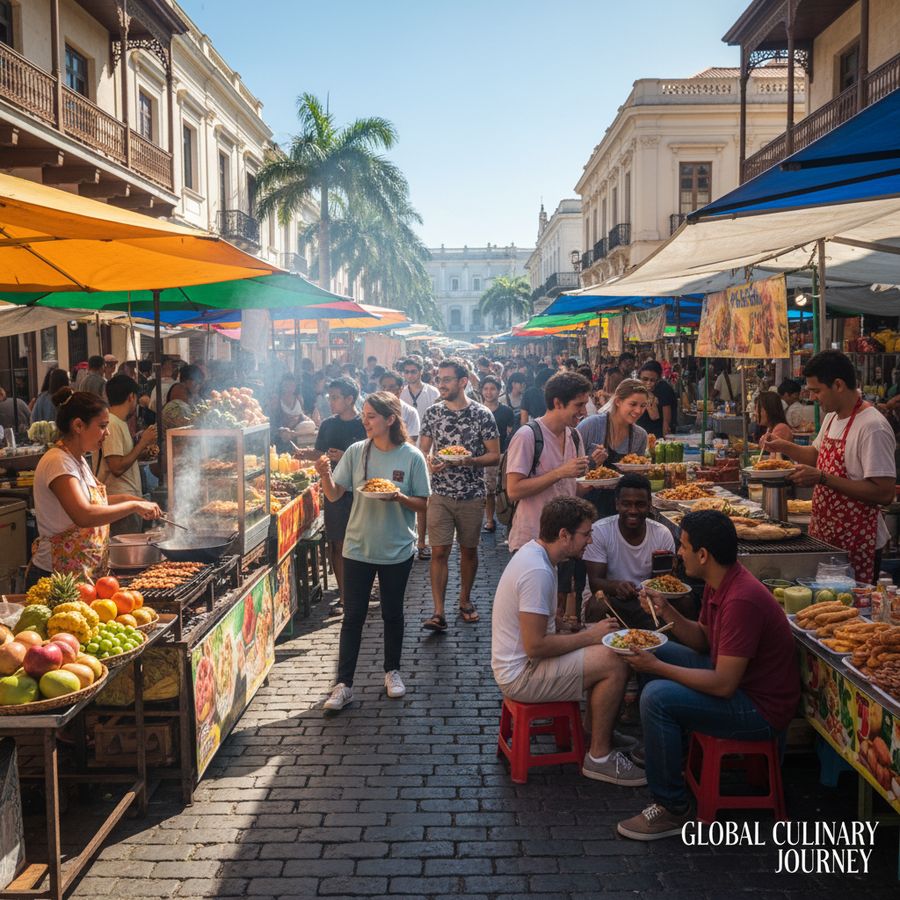Overview
Street food offers an unparalleled gateway into the world of traditional cuisine, inviting food lovers on a captivating culinary journey that transcends borders and cultures. These accessible and often affordable food options found on the streets provide a unique perspective on a region’s food culture, showcasing authentic recipes crafted with locally sourced ingredients and time-honored techniques.
Unlike formal dining, street food thrives on spontaneity and freshness, reflecting the vibrant everyday life of cities and towns worldwide. It is here that food meets community, where recipes passed down through generations are shared and enjoyed by locals and travelers alike. This dynamic culinary scene not only satisfies hunger but also tells the story of cultural identity and heritage.
Exploring traditional street food allows one to experience the heart of a culture in bite-sized portions. From sizzling grills to aromatic spices, the street food landscape is diverse and rich, offering everything from savory snacks to sweet treats. This form of traditional cuisine is not only about eating; it is about engaging with the history, people, and environments that shape these dishes.
As global interest in authentic recipes and cultural gastronomy grows, street food has gained recognition as a valuable culinary art form. Its role in shaping local economies and tourism also highlights its significance beyond just nourishment. This blog post embarks on an exploration of some of the most popular street foods worldwide, their cultural significance, ingredients, preparation methods, and how to find authentic dishes while considering health aspects.
“Street food is a vibrant tapestry of culture, tradition, and flavor, offering a delicious insight into the soul of a community.”

Popular Street Foods Worldwide
The world of street food is as varied as the cultures it represents. Across continents, certain dishes have become iconic symbols of their countries, celebrated for their unique flavors and traditional preparation methods. Exploring these popular street foods provides a delicious snapshot of global culinary heritage.
In Asia, street food is renowned for its bold spices and fresh ingredients. For example, Thailand’s Pad Thai is a stir-fried noodle dish bursting with flavors from tamarind, peanuts, and fresh herbs. Similarly, India’s Chaat offers a medley of textures and tastes, combining crispy fried dough with tangy tamarind sauce and aromatic spices.
Moving to the Americas, Mexico’s Tacos stand out as a beloved street food, featuring soft corn tortillas filled with grilled meats, fresh salsa, and avocado. In the United States, food trucks popularize dishes like gourmet burgers and fusion tacos, blending traditional recipes with contemporary twists.
In Europe, street food often reflects centuries-old culinary traditions. For example, Belgium’s Waffles are crispy on the outside and soft inside, often enjoyed with powdered sugar or fresh fruit. In Turkey, Kebabs served from street vendors offer savory grilled meats accompanied by fresh vegetables and flatbreads.
Popular street foods worldwide share common traits: they are made with fresh ingredients, prepared quickly, and enjoyed in informal settings. This accessibility and authenticity have fueled the global appeal of street food, making it a must-try for travelers and food enthusiasts seeking genuine cultural experiences.
- Asian Delights: Pad Thai, Banh Mi, Sushi
- Latin American Favorites: Tacos, Arepas, Empanadas
- European Staples: Waffles, Kebabs, Crepes
- African Specialties: Bunny Chow, Suya, Mandazi

Cultural Significance
Traditional street food serves as more than just a meal; it is a reflection of cultural identity and social fabric. Each dish carries stories of migration, adaptation, and community values, preserving culinary heritage in a rapidly globalizing world.
Street food often emerges from the necessity of providing affordable and nourishing meals to the working class, becoming embedded in local customs and daily routines. It acts as a communal experience where people from different backgrounds converge, fostering social connections and shared traditions.
In many societies, street food vendors are custodians of authentic recipes passed down through generations. Their cooking methods and ingredient choices are deeply rooted in cultural practices, often linked to religious and seasonal festivities. As a result, street food becomes a living archive of a community’s history and values.
“The cultural significance of street food lies in its power to bring people together, offering a taste of history and tradition in every bite.”
Moreover, street food markets are vibrant hubs of cultural exchange, where visitors can experience the diversity and richness of a locale’s food culture. This dynamic environment supports local economies and encourages culinary innovation while respecting traditional practices.
Understanding the cultural significance of street food enriches the culinary journey by connecting flavors with the people and stories behind them, highlighting the importance of preserving these authentic recipes in an ever-changing world.
Ingredients and Preparation
The allure of traditional street food lies in its use of fresh, locally sourced ingredients combined with time-tested preparation techniques. These elements come together to create dishes that are flavorful, satisfying, and true to their cultural origins.
Street food vendors often emphasize simplicity and efficiency, using staple ingredients such as fresh vegetables, herbs, spices, and proteins that are readily available. The preparation methods vary widely but typically involve grilling, frying, steaming, or slow-cooking to bring out unique textures and flavors.
Many recipes depend on secret spice blends or marinades, handed down through families, that define the authentic taste of a dish. For instance, spices like cumin, coriander, and chili play essential roles in many street food recipes worldwide, contributing to their distinct profiles.
Preparation is often a public spectacle; vendors skillfully assemble dishes on the spot, ensuring freshness and engaging with customers. This hands-on approach not only guarantees quality but also adds to the vibrant atmosphere of street food culture.
Additionally, the use of traditional cooking equipment such as charcoal grills, clay ovens, or large woks helps maintain the authenticity of recipes and flavors. The combination of these elements makes street food a genuine representation of local culinary craftsmanship.
- Locally sourced fresh vegetables and herbs
- Traditional spice blends and marinades
- Cooking techniques: grilling, frying, steaming
- Use of authentic cooking equipment
Mastering these ingredients and preparation methods is key to preserving the essence of traditional street food, making every bite a connection to its cultural roots.
Where to Find Authentic Dishes
Discovering authentic traditional street food requires more than just visiting popular tourist spots; it involves exploring local neighborhoods, markets, and food stalls where genuine recipes are preserved and celebrated.
Authenticity is often found away from heavily commercialized areas, in locations where vendors cater primarily to locals. These hidden gems offer dishes made from age-old recipes and prepared with care, providing an immersive culinary experience.
Many cities around the world boast dedicated street food markets or festivals that showcase regional specialties. Visiting these events is an excellent way to sample a variety of authentic recipes and learn about the cultural context of the dishes.
Food tours led by knowledgeable local guides can also enhance the journey, providing insights into the history, ingredients, and traditions behind each dish. This approach ensures that travelers engage with the food culture respectfully and meaningfully.
Moreover, online communities and review platforms dedicated to street food can help identify highly recommended vendors known for their authentic offerings. Engaging with these resources encourages a deeper appreciation of the culinary journey.
“Authentic street food is best savored where tradition lives daily—among the people and places that cherish their culinary heritage.”
Health Considerations
While street food offers a delicious dive into traditional cuisine, it is important to consider health aspects to ensure a safe and enjoyable experience. Understanding how to choose vendors and dishes wisely can help mitigate potential risks.
Food safety practices among street vendors vary widely depending on local regulations and infrastructure. Prioritizing stalls that demonstrate cleanliness, proper food storage, and cooking at appropriate temperatures reduces the risk of foodborne illnesses.
Travelers and food enthusiasts should also be mindful of ingredients used in street food, particularly for those with allergies or dietary restrictions. Many traditional recipes incorporate spices, nuts, or gluten-containing components that may require caution.
Moreover, balance is key when indulging in street food. While these dishes are often flavorful and rich, moderating portion sizes and complementing meals with fresh fruits or vegetables can contribute to healthier eating habits during culinary explorations.
To enjoy street food safely, consider the following tips:
- Choose vendors with visible hygiene standards and high customer turnover
- Avoid raw or undercooked dishes when uncertain about preparation
- Stay hydrated and consume food from trusted sources
- Inform vendors of any allergies or dietary needs when possible
Health considerations enhance the overall street food experience, allowing you to savor authentic recipes while prioritizing well-being on your culinary journey.
Conclusion
Exploring traditional street food is an enriching culinary journey that opens doors to diverse cultures, authentic recipes, and vibrant food cultures worldwide. This form of cuisine encapsulates history, community, and creativity within every dish, offering an accessible yet profound connection to the places and people behind the food.
From iconic street foods across continents to the cultural significance embedded in each bite, street food represents more than nourishment—it is a celebration of tradition and innovation. By appreciating the ingredients, preparation methods, and respecting health considerations, enthusiasts can fully immerse themselves in this dynamic world.
Whether you are a seasoned traveler or a curious food lover, embracing the authentic flavors of street food enriches your understanding of global food culture and leaves lasting memories. Step outside the conventional dining experience and savor the stories, aromas, and tastes that make traditional street food a treasured culinary treasure.
“The journey through traditional street food is a delicious adventure that unites us through shared flavors and cultural heritage.”
Leave a Reply